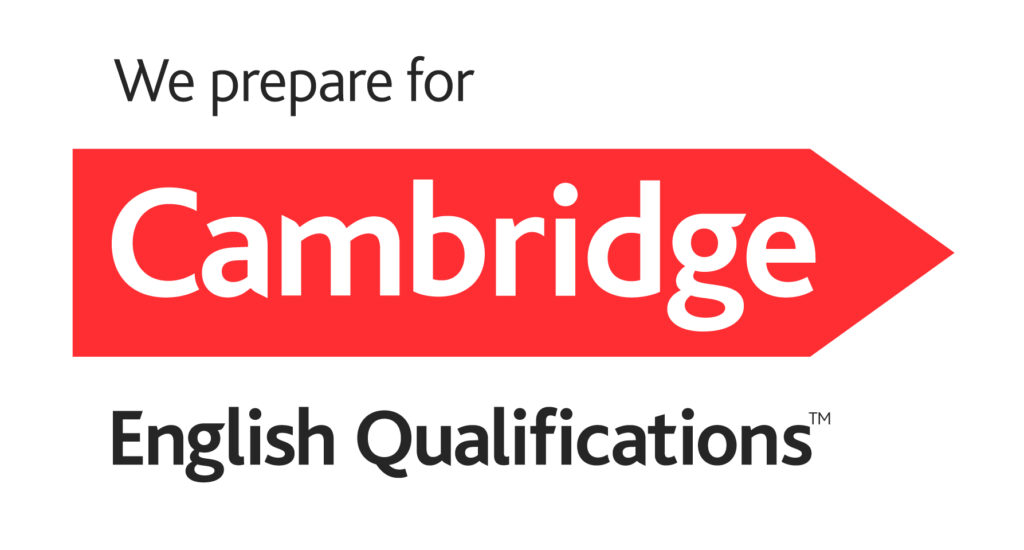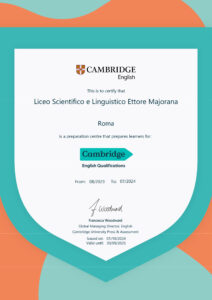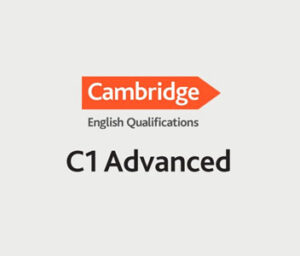

Exam Preparation Centre
Il Liceo Majorana articola la preparazione agli Esami di certificazione Cambridge English in corsi curricolari, extracurricolari e di simulazione, come qui di seguito schematizzato:
| corsi curricolari | corsi extracurricolari | |
| destinatari | studenti interni | studenti e adulti, sia interni che esterni |
| orario | antimeridiano | pomeridiano |
| livelli | B1 e B2 | B1, B2, C1, C2 |
| tot. ore | 30 | 40 |
| docenti | titolari di cattedra | esperti esterni |
| costi | nessuno | 250€ |
I corsi curricolari sono parte integrante della programmazione del Dipartimento di Inglese su cui si basa il programma annuale predisposto dal singolo docente titolare di cattedra. L’iscrizione agli esami non è obbligatoria, ma a tutti è così garantita la preparazione necessaria al conseguimento del livello B1 al termine del biennio e del livello B2 al termine del triennio. Per i dettagli si rimanda alla programmazione al link.
I corsi extracurricolari tenuti da esperti esterni sono offerti sulla base di un progetto di ampliamento dell’offerta formativa finalizzato alla promozione delle eccellenze e all’apertura al territorio. Sono quindi rivolti sia a studenti che adulti sia interni che esterni. Sono tenuti da esperti esterni e organizzati sulla base delle iscrizioni raccolte, compilando il seguente modulo.
Le classi e il calendario per l’a.s. 2024-25 sono:
- PET lunedì/mercoledì ore 14.30-16.00
- FCE lunedì ore 14.30-16.00 – martedì/giovedì ore 15.00-16.30
- CAE mercoledì ore 14.45-16.15
Per ulteriori dettagli si rimanda alle relative Circolari.
Il Liceo è sede d’esame riconosciuta dall’Università Cambridge, e prevede almeno due sessioni l’anno. L’apertura delle iscrizioni, a prescindere dalla preparazione svolta a scuola, è segnalata con congruo anticipo. Le istruzioni per l’iscrizione e il calendario del corso di simulazione per le sessioni d’esame sono indicate di seguito per ogni livello di certificazione.
La Docente Referente per l’organizzazione delle sessioni d’esame è la prof.ssa Cinzia Azzaretto
cinzia.azzaretto@liceomajorana.edu.it
Per sostenere la sessione d’esami dell’Università di Cambridge PET (liv. B1), FCE (liv. B2), CAE (liv. C1), o CPE (liv. C2), bisogna formalizzare, entro le scadenze delle sessioni, la propria manifestazione di interesse compilando il seguente modulo. Tale procedura risulterà vincolante e propedeutica alla finalizzazione dell’iscrizione, le cui modalità e termini sono di seguito specificate.
| Sessioni d’esame a.s. 2024-25 |
Cambridge English Preliminary B1
- costo 125,00€ versare tramite PagoInRete
- date esame e scadenze iscrizioni:
| PET FS (B1) | Sessione Maggio | Scadenza iscrizioni | Sede d'esame |
| PET FS Paper Based | 31/05/2025 | 29/03/2025 | Liceo ‘E. Majorana’ - Via Avolio, 111 |
| Sessione Giugno | Scadenza iscrizioni | Sede d'esame | |
| PET FS Paper Based | 15/06/2025 | 04/04/2025 | IC Alessandro Magno - Casal Palocco Axa |
| Sessione Luglio | Scadenza iscrizioni | Sede d'esame | |
| Pet for schools Digital | 09/07/2025 | 04/06/2025 | LIA - Via Demostene - Casal Palocco |
| Pet for schools Digital | 30/07/2025 | 20/06/2025 | LIA - Via Demostene - Casal Palocco |
CAMBRIDGE ENGLISH PRELIMINARY
| Paper | Content | Marks | What's in each part? | |||
| Part | Questions or length | % | Scale | |||
| Reading and Writing (1 hour 30 minutes) You have to read and understand the main points from signs, newspapers and magazines, and use vocabulary and structure correctly. | Reading | I | 5 | 50% | 0 - 35 | Five very short texts. Multiple choice (A, B or C). |
| II | 5 | Five short descriptions of people and eight short texts to read. Matching each person to a text. | ||||
| III | 10 | A long text and ten sentences about it. Say if each sentence is true or false. | ||||
| IV | 5 | A long text and five questions. Multiple choice (A, B, C or D). | ||||
| V | 10 | A short text with ten missing words. Multiple-choice cloze (A, B, C or D). | ||||
| Writing | I | 5 | 0 - 5 | Sentence transformations. Complete the 2nd sentence with no more than 3 words so that it means the same as the 1st sentence. | ||
| II | 35-45 words | 0 - 5 | A short communicative message (a postcard, a note, an email, etc.). | |||
| III | 100 words | 0 - 15 | Continuous writing You can chose between an informal letter or a story. | |||
| Listening (30 minutes) You have to understand a range of spoken materials including announcements and discussions about everyday life. | I | 7 | 25% | 0 - 25 | 7 short conversations. Multiple choice (picture A, B or C). | |
| II | 6 | A long recording and questions. Multiple choice (answer A, B or C). | ||||
| III | 6 | A long monologue and notes on it. Gap-fill (missing information). | ||||
| IV | 6 | A long informal conversation. True or false (six sentences). | ||||
| Speaking (10-12 minutes per pair of candidates) You take part in conversations by asking and answering questions and talking, e. g., about your likes and dislikes. Your Speaking test will be conducted face to face with one or two other candidates and two examiners. | I | 2-3 minutes | 25% | 0 - 25 | Interview with the examiner The examiner asks you information about yourself (past, present, future). | |
| II | 2-3 minutes | Discussion with the other candidate The examiner describes a situation and gives you a paper with six possible solutions; you have to discuss the alternatives and decide the best one (suggesting, disagreeing, agreeing). | ||||
| III | 2 minutes | Extended turn You have to describe a photograph. | ||||
| IV | 3 minutes | General conversation The two candidates discuss the topic which links the two photos (giving and asking opinions, likes/dislikes, etc.). | ||||
For tips and advice to prepare for your test visit the Cambridge English site.
| CEFR Level | Examination | Test Score | C.E. Scale | Results |
| B2 | FCE | 90 to 100 | 160 - 170 | Pass with Distinction (Grade A) |
| B1 | PET | 85 to 89 | 153 - 159 | Pass with Merit (Grade B) |
| 70 to 84 | 140 - 152 | Pass (Grade C) | ||
| A2 | KET | 45 to 69 | 120 - 139 | Level A2 |
| A1 | 0 to 44 | Fail |
Cambridge English Scale Score Converter
Cambridge English First B2
- costo 212,00€ da versare tramite PagoInRete
- date esame e scadenze iscrizioni:
| FCE fs (B2) | Sessione Maggio | Scadenza iscrizioni | Sede d'esame |
| First for schools Digital | 24/05/2025 | 18/04/2025 | LIA - Via Demostene - Casal Palocco |
| First fs Paper Based | 31/05/2025 | 29/03/2025 | Liceo ‘E. Majorana’ - Via Avolio, 111 |
| Sessione Giugno | Scadenza iscrizioni | Sede d'esame | |
| First for schools Digital | 08/06/2025 | 30/04/2025 | LIA - Via Demostene - Casal Palocco |
| First fs Paper Based | 13/06/2025 | 04/04/2025 | LIA - Via Demostene - Casal Palocco |
| Sessione Luglio | Scadenza iscrizioni | Sede d'esame | |
| First for schools Digital | 09/07/2025 | 04/06/2025 | LIA - Via Demostene - Casal Palocco |
| First for schools Digital | 30/07/2025 | 20/06/2025 | LIA - Via Demostene - Casal Palocco |
 | |||||||
| Paper | Content | Marks | FORMAT | FOCUS | |||
| Part | Questions or length | % | Scale | ||||
| Reading and Use of English(1h 15')tot. 52 questions (in 7 parts) tot. 2200-2500 words to read from newspaper and magazine articles, reports, fiction, advertisements, letters, messages, informational material (e.g. brochures, guides, manuals, etc.). | You have to read and understand a range of texts and do grammar and vocabulary tasks | I | 8 | 40% | 0-8 | MULTIPLE CHOICE CLOZE A text in which there are some missing words or phrases (gaps). After the text there are four possible answers for each gap and students have to choose the correct answer (A, B or C). (about 11 minutes) | VOCABULARY: idioms, collocations, fixed phrases, complementation, phrasal verbs, semantic precision. |
| II | 8 | 0-8 | OPEN CLOZE There are some missing words (gaps). Students have to write the correct word in each gap. (11' ca.) | GRAMMAR awareness and control, with some focus on vocabulary. | |||
| III | 8 | 0-8 | WORD FORMATION A text containing eight gaps. Each gap corresponds to a word. At the end of the line there is a ‘prompt’ word which the student has to change in some way to make the correct missing word and complete the sentence correctly. (11' ca.) | VOCABULARY: the use of affixation, internal changes and compounding in word formation. | |||
| IV | 6 | 0-12 | KEY WORD TRANSFORMATIONS A sentence followed by a key word and a second sentence which has a gap in it. Students have to use the key word to complete the second sentence (using 2-5 words) so that it is similar in meaning to the first sentence. (about 10 minutes) | GRAMMAR, VOCABULARY and COLLOCATION | |||
| You have to read a series of texts and answer questions that test reading ability and show that you can deal with a variety of different types of texts. | V | 6 | 0-12 | MULTIPLE CHOICE A text followed by six multiple-choice questions. Each question has four options (A, B, C or D), and students have to decide which is the correct answer. (11' ca.) | READING SKILLS: Detail, opinion, attitude, tone, purpose, main idea, gist, meaning from context, implication, text organisation fetures (exemplification, reference). | ||
| VI | 6 | 0-12 | GAPPED TEXT A text with six empty spaces (gaps). After the text there are six sentences taken from the text and an additional sentence; the sentences are given in jumbled order. Students have to choose the correct sentence for each gap. (11' ca.) | READING SKILLS: Cohesion, coherence, text structure. | |||
| VII | 10 | 0-10 | MULTIPLE MATCHING A series of questions and a long text or several short texts to read. For each question, students have to decide which text or part of the text mentions this. (10' ca.) | READING SKILLS: Detail, opinion, specific information, implication. | |||
| Writing (1 hour 20 minutes) You have to produce two different pieces of writing: a compulsory task and one from a choice of three. | I | 140-190 words | 20% | 0-20 | ESSAY An opening rubric and a question with two given prompts, plus a prompt requiring candidates to write about their own additional idea. | Agreeing or disagreeing, giving information, opinion or reasons, comparing and contrasting, drawing a conclusion. | |
| II | 140-190 words | 0-20 | ARTICLE, LETTER, EMAIL, REPORT or REVIEW A task selected from a choice of three and based on a range of general topics, such as health and fitness, sport, music, etc. | Putting together and developing personal ideas on a topic, with a purpose for writing and a target reader in mind. | |||
| Listening (40 minutes) You have to understand a range of spoken materials, including lectures, radio broadcasts, speeches and talks. | I | 8 | 20% | 0-30 | MULTIPLE CHOICE (answer A, B or C). Short unrelated extracts from monologues or exchanges between interacting speakers. | Genre, feeling, attitude, topic, opinion, purpose, agreement, gist and detail. | |
| II | 10 | SENTENCE COMPLETION A 3-4 minutes monologue | Detail, specific information and stated opinion. | ||||
| III | 5 | MULTIPLE MATCHING Five short related monologues and five questions with eight options each. | General gist, detail, attitude, opinion, etc. | ||||
| IV | 7 | MULTIPLE CHOICE A 3-4 minute interview or exchange between two speakers and seven questions with three options each. | Opinion, attitude, detail, gist, main idea and specific information. | ||||
| Speaking (14 minutes per pair of candidates) You take part in conversations by asking and answering questions and talking, with the examiner, with the other candidate and by yourself. Your Speaking test will be conducted face to face with one or two other candidates and two examiners. | I | 2 minutes | 20% | 0-25 | INTERVIEW The examiner asks you information about yourself (past, present, future). | General interactional and social language | |
| II | 4 minutes | LONG TURN DISCOURSE The examiner gives each candidate a photograph to talk about; each candidate has a 1-minute individual long turn to talk about the situation given and answer the question with reference to both potographs; then the other candidate has to give a 30-second personal response. | Organising a larger unit of discourse; comparing, describng and expressing opinions. | ||||
| III | 4 minutes | COLLABORATIVE TASK Candidates are given spoken instructions and written stimuli to discuss about (2 minutes) in order to make a decision (1 minute). | Sustaining an interaction, exchanging ideas, expressing and justifying opinions, agreeing and/or disagreeing, suggesting, speculating, evaluating, reaching a decision through negotiation, etc. | ||||
| IV | 4 minutes | DISCUSSION The two candidates discuss the topic related to the collaborative task. | Expressing and justifying opinions, agreeing and/or disagreeing, speculating. | ||||
For tips and advice to prepare for your test visit the Cambridge English site.
| CEFR Level | Examination | Test Score | C.E. Scale | Results |
| C1 | CAE | 90 to 100 | 180 - 190 | Pass with Distinction (Grade A) |
| B2 | FCE | 85 to 89 | 173 - 179 | Pass with Merit (Grade B) |
| 70 to 84 | 160 - 172 | Pass (Grade C) | ||
| B1 | PET | 45 to 69 | 140 - 159 | Level B1 |
| A2 | KET | 0 to 44 | 120 - 139 | Fail |
Cambridge English Scale Score Converter
| RESOURCES |
| English Exam Help FCE |
| Flo-Joe FCE |
Cambridge English Advanced
- costo 230,00€ da versare tramite PagoInRete
- date esame e scadenze iscrizioni:
| CAE (C1) | Sessione Maggio | Scadenza iscrizioni | Sede d'esame |
| CAE Advanced Digital | 17/05/2025 | 04/04/2025 | LIA - Via Demostene - Casal Palocco |
| CAE Advanced PAper Based | 31/05/2025 | 29/03/2025 | Liceo ‘E. Majorana’ - Via Avolio, 111 |
| Sessione Giugno | Scadenza iscrizioni | Sede d'esame | |
| CAE Advanced Digital | 16/06/2025 | 10/05/2025 | LIA - Via Demostene - Casal Palocco |
| Sessione Luglio | Scadenza iscrizioni | Sede d'esame | |
| CAE Advanced Digital | 07/07/2025 | 04/06/2025 | LIA - Via Demostene - Casal Palocco |
| CAE Advanced Digital | 28/07/2025 | 20/06/2025 | LIA - Via Demostene - Casal Palocco |

Cambridge English Proficiency
- costo 235,00€ Paper based e 240,00€ Computer based da versare tramite PagoInRete
- date esame e scadenze iscrizioni:
| CPE (C2) | sessione primaverile | scadenza iscrizioni | sede d'esame |
| Computer based | |||
| Computer based | |||
| Paper based |
Consulta i dizionari online per consolidare e ampliare il lessico.




